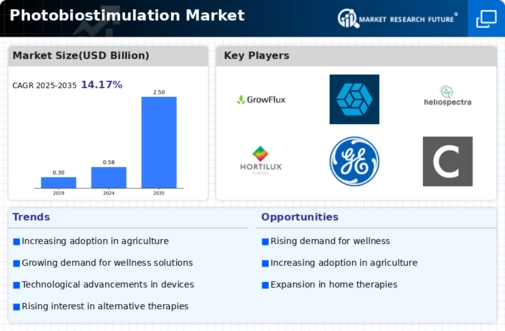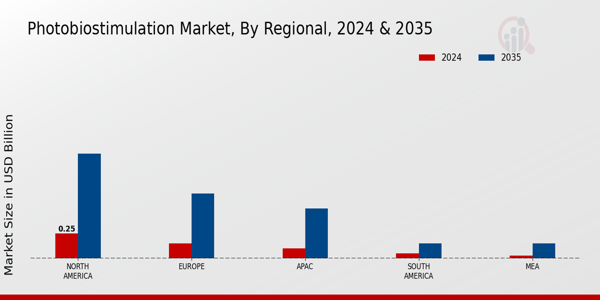Market Growth Projections
The Global Photobiostimulation Market Industry is projected to experience substantial growth over the next decade. With an estimated value of 0.58 USD Billion in 2024, the market is anticipated to reach 2.5 USD Billion by 2035. This growth trajectory suggests a compound annual growth rate of 14.2% from 2025 to 2035. Factors contributing to this expansion include technological advancements, increasing awareness of non-invasive treatments, and a rising incidence of chronic conditions. As the market evolves, it is likely to attract new entrants and foster innovation, further enhancing its potential.
Rising Incidence of Chronic Conditions
The Global Photobiostimulation Market Industry is significantly influenced by the rising prevalence of chronic conditions such as arthritis, diabetes, and cardiovascular diseases. These conditions often require long-term management strategies, and photobiostimulation offers a complementary approach to traditional treatments. By promoting tissue repair and reducing pain, light therapy can enhance the quality of life for patients. As healthcare systems worldwide seek effective solutions to manage these conditions, the market is poised for growth. The increasing recognition of photobiostimulation as a viable treatment option is expected to drive market expansion, particularly in regions with aging populations.
Growing Demand for Non-Invasive Treatments
The Global Photobiostimulation Market Industry is experiencing a surge in demand for non-invasive treatment options. Patients and healthcare providers are increasingly favoring therapies that minimize discomfort and recovery time. Photobiostimulation, which utilizes light to promote healing and reduce inflammation, aligns with this trend. For instance, in dermatology, photobiomodulation is employed for skin rejuvenation and acne treatment, demonstrating its effectiveness. As awareness of these benefits spreads, the market is projected to grow from 0.58 USD Billion in 2024 to an estimated 2.5 USD Billion by 2035, indicating a robust shift towards non-invasive modalities.
Expanding Applications in Aesthetic Medicine
The Global Photobiostimulation Market Industry is witnessing an expansion of applications within aesthetic medicine. Photobiostimulation is increasingly utilized for cosmetic procedures, including skin rejuvenation, hair restoration, and wound healing. The non-invasive nature of these treatments appeals to a broad demographic, particularly among younger consumers seeking preventive care. As aesthetic procedures become more mainstream, the market is likely to benefit from heightened consumer interest. This trend is further supported by the growing availability of photobiostimulation devices in clinics and at-home settings, enhancing accessibility and convenience for users.
Increased Investment in Research and Development
The Global Photobiostimulation Market Industry is bolstered by increased investment in research and development. Governments and private entities are recognizing the potential of photobiostimulation technologies and are funding studies to explore their efficacy across various medical applications. This investment is leading to a deeper understanding of the mechanisms behind light therapy and its effects on cellular processes. As new findings emerge, they are likely to pave the way for innovative treatments and expand the market's scope. The ongoing commitment to research is expected to sustain growth and drive advancements in the field.
Technological Advancements in Light Therapy Devices
Technological innovations are propelling the Global Photobiostimulation Market Industry forward. Advances in laser and LED technologies have led to the development of more effective and versatile light therapy devices. These devices are now capable of delivering precise wavelengths and dosages, enhancing treatment outcomes across various medical fields. For example, portable devices for home use are becoming increasingly popular, allowing patients to manage their conditions conveniently. This trend is likely to contribute to a compound annual growth rate of 14.2% from 2025 to 2035, as the market adapts to the evolving needs of consumers and healthcare providers.












